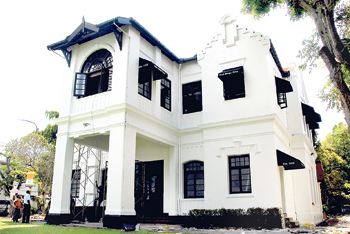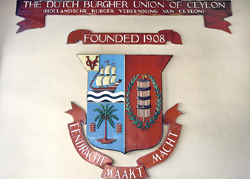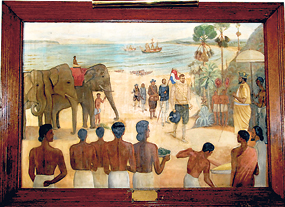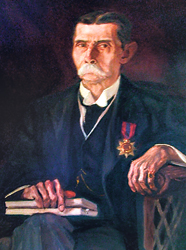The Dutch Burgher Union of Ceylon (DBU), with its distinctive and grand old clubhouse situated opposite the Havelock Road and Buller’s Road roundabout in Bambalapitiya, has reached a significant milestone in 2008. Yes, it is one hundred years old! Now in its centenary year, the DBU has a variety of events to mark the occasion with the most prominent being planned for October 22, the DBU ‘Founder’s Day’.
 |
| Getting a facelift : The DBU building today. Pix by Sanka Vidanagama |
Established in 1908 with the objective of promoting the moral and social well-being of the Dutch Burgher community in Ceylon, Richard Gerald Anthonisz, a historian and scholar, is largely credited as being the Founder of the DBU. He was its Secretary from 1908 to 1915, and its President from 1916 till his death in 1930 - the longest reign by any President of the Union to date. His dedication to the establishment and expansion of the DBU was unmatched. So much so that after his death, the anniversary celebration of the DBU was shifted from its inauguration date (January 18, 1908) to his birthday which fell on October 22nd. This date has been the principal annual commemoration event of the DBU for more than 60 years and is known as Founder’s Day.
The first fifty years of the DBU
The glory days of the DBU were undoubtedly during its first half century of existence, when the Burgher community held sway in every sphere of life including the legal and medical professions, theatre and sports. Certainly, the leadership of the DBU during this phase in particular, boasted some of the finest luminaries in the country. These included Richard Lionel Spittel, the great surgeon and anthropologist who devoted much of his life to the study of the original inhabitants of the island, the Veddahs.
In addition to being the foremost authority on the Veddahs, Dr. R.L. Spittel was also a wildlife conservationist, author and philanthropist, and one of the best and brightest sons of Sri Lanka. He was also an active member of the DBU and was its President from 1936 to 1938. Dr. Spittel’s philanthropy included the donation of a large tract of land in Dehiwela for the construction of a home for elderly ladies. St Nikolaas’ Home, as it was named, remains one of the principal responsibilities of the DBU to this day and is a home away from home to nearly 50 Burgher ladies.
While space does not permit elaborating on the many great leaders and personalities of the DBU, it would be remiss not to make mention of the other great Doctor with the identical initials, Dr. R. L. Brohier. Dr. Richard Leslie Brohier was a surveyor by profession who received an honorary doctoral degree from the University of Ceylon, in recognition for his outstanding contribution in documenting the history of Sri Lanka and for charting the lay of the land. Dr. Brohier was the first Ceylonese surveyor and a prolific author, drawing on his vast experience having traversed the length and breadth of the island for nearly 40 years, from the early 1900s.
 |
| The DBU crest with its motto “Union is Strength” |
Dr. Brohier’s writings encompass his wide array of interests ranging from the 2500 year old history of Sri Lanka, to its inhabitants and its glorious geographical composition and are regarded as among the most important in those respective fields. He was also an authority on the ancient irrigation works of Sri Lanka on which he authored a book. Dr. Brohier was President of the DBU from 1953 to 1955.
Indeed, the Burghers were renowned for their great love of the land and no one epitomised this more than the two Dr. R.L.’s.
The Burgher community was also notable for their literary pursuits and in fact this was one of the most encouraged facets by the leaders of the DBU in those early days. This is substantiated by the publications of the Journals of the Dutch Burgher Union (JDBU). The JDBU are treasured items by Sri Lankan historians and genealogists around the world and were first published in 1908, the same year in which the DBU was established. The JDBU are an excellent resource for researching material on the Dutch Burgher community in Sri Lanka, particularly in the pre-migration period of the late 1950s. Up to this point, when the community and the Union enjoyed strength in numbers, the JDBU was published with regularity and presents a broad insight into the lives and times of the community spanning the first half of the twentieth century.
Apart from being an insightful glimpse on the evolution of a community, perhaps the most significant feature of the JDBU is the 200 plus genealogies of Dutch Burgher families published, dating back to their ancestors who arrived during the Dutch period of Rule under the VOC (Dutch East India Company) from 1656 to 1796. The name Altendorff is synonymous with Burgher genealogies, as it was he who researched and documented most of these. With the emergence of the Internet, these genealogies have become highly sought after by the many serious and not-so-serious genealogy enthusiasts.
The next fifty years
The second half of the history of the DBU has undoubtedly been less spectacular, but no less resilient, under the circumstances. Following Ceylon’s ‘independence’ in 1948, and more gravely, the ‘Sinhala Only’ policy, introduced by the government in 1956, the Burgher community found themselves in turmoil with the country that they loved.
 |
| A painting by C.L. Beling in the hall depicts the landing of Admiral Joris van Spilbergen near Batticaloa in May 1602 |
After the British assumed colonial rule in 1796, the language of the new colonial masters, English had been adopted by the Burgher community and had since evolved into their primary language, or perhaps more accurately, into the only language that they were adept at from a professional standpoint at any rate.
While criticism was cast in their direction at the time for jumping ship so to speak; and examples proffered on how previous generations had adapted themselves to a new language, the reality is that this was not of the same equation or magnitude. Their forbears adapting to English was a less daunting prospect as apart from other practical reasons, it was clear by then that the English language was the language of the incumbent world superpower and ostensibly, English would spread far and wide and evolve as a global language. ‘Sinhala Only’, on the other hand, opened the possibility of locking their subsequent generations into a language that offered little global value beyond the shores of the beautiful tear drop-shaped island.
For many, this prospect alone determined their fate and the vast majority, many of whom enjoyed a lifestyle in Ceylon that they would have found hard to replicate anywhere else, nevertheless sought the shores of predominantly English-speaking Australia for the sake of their children and future generations. Perhaps their actions were vindicated when, in later years, families from all the other communities in Sri Lanka were to emulate the Burghers in following them to Australia in as great or even greater numbers, and continue to do so to this day!
 |
| Founder of DBU: Richard Gerald Anthonisz |
Notwithstanding the mass migration of the Burgher community, their presence in the context of the contemporary Dutch Burgher Union has only diminished in a physical sense. Having galvanised themselves into a variety of organisations in their new country, the expatriate Burgher community has been magnanimous in continuing to provide substantial and invaluable support. This has helped to sustain the St Nikolaas’ Home for elderly ladies along with the many hundreds of individual Burghers and their families in Sri Lanka who have been able to stay afloat due to the generosity of a large chunk of the community who have been long gone, but who have not long forgotten.
In terms of the clubhouse and its social activities, the DBU has enjoyed a mighty resurgence in the past four to five years, the proportions of which Lazarus would be proud! The restoration of the DBU building to its original magnificence has contributed in no small measure to its success and its 400 plus members are now justifiably proud. It may fall short of the dizzy heights of the ’20s, ’30s and ’40s, but the renewed enthusiasm and great sense of optimism augurs well for the continued and proud existence of the Dutch Burgher Union of Ceylon in Sri Lanka.
More information on the Dutch Burgher Union including the Journals and genealogies can be found at its website - www.dutchburgherunion.org
- David Colin-Thomé
|
